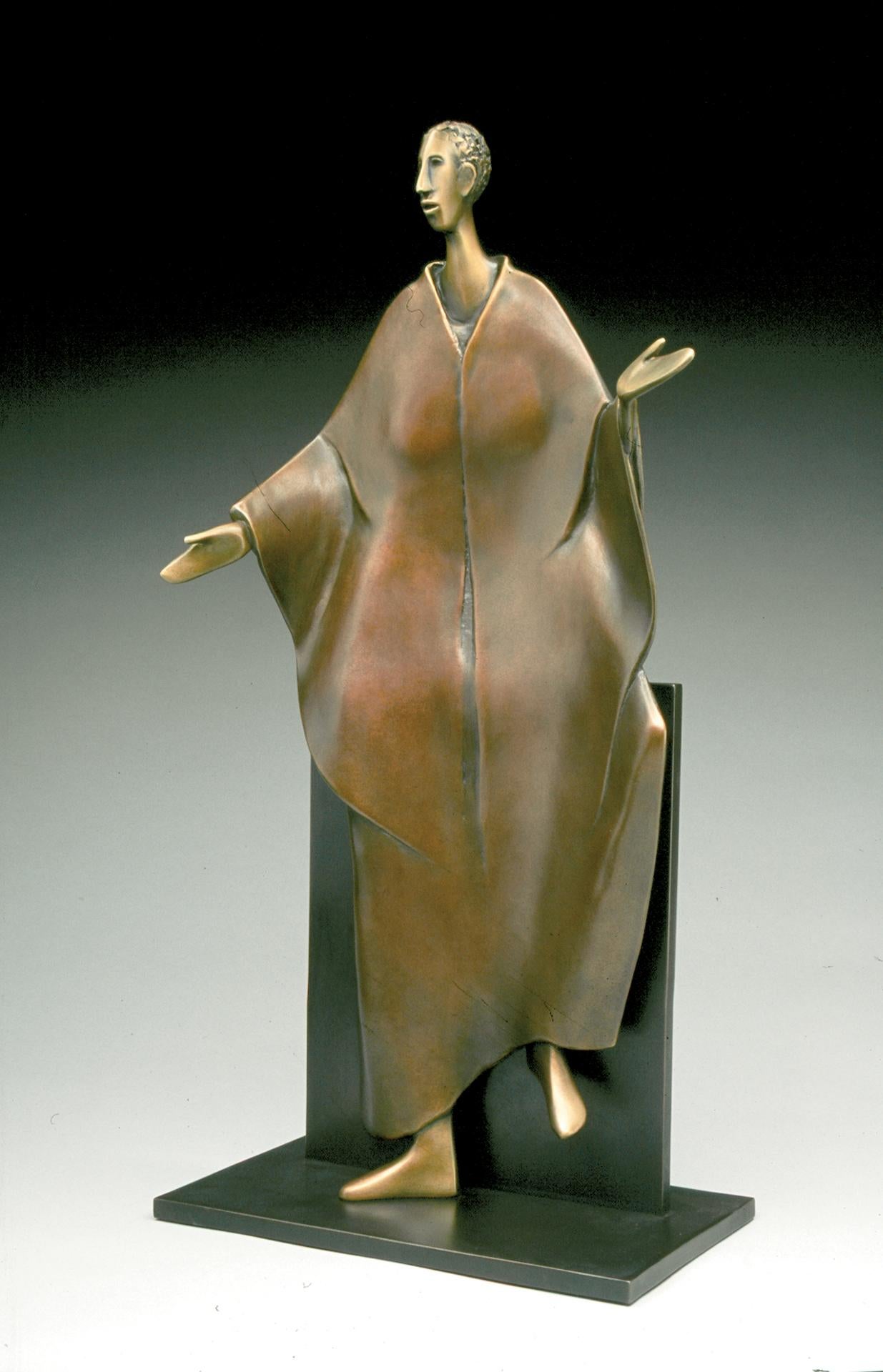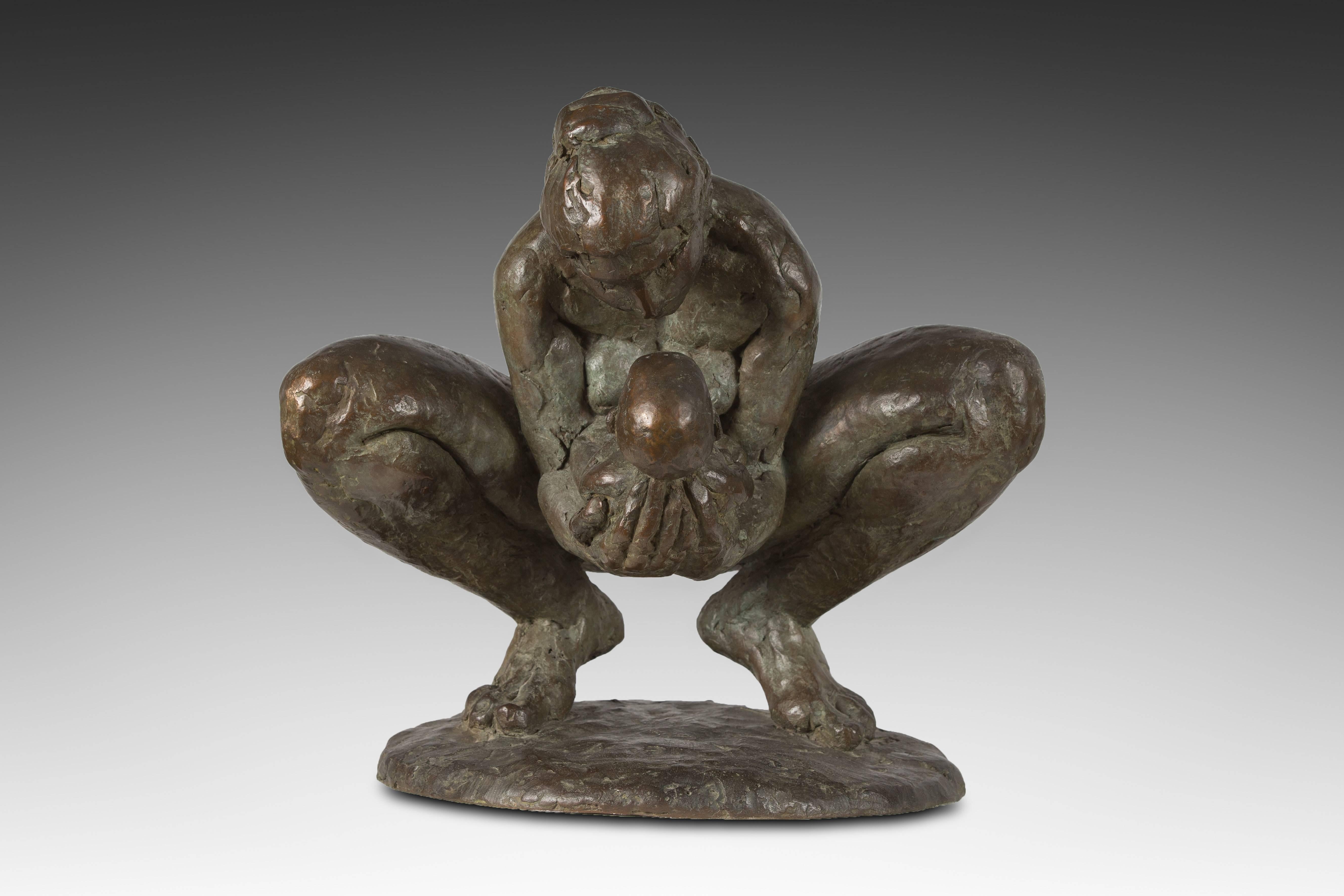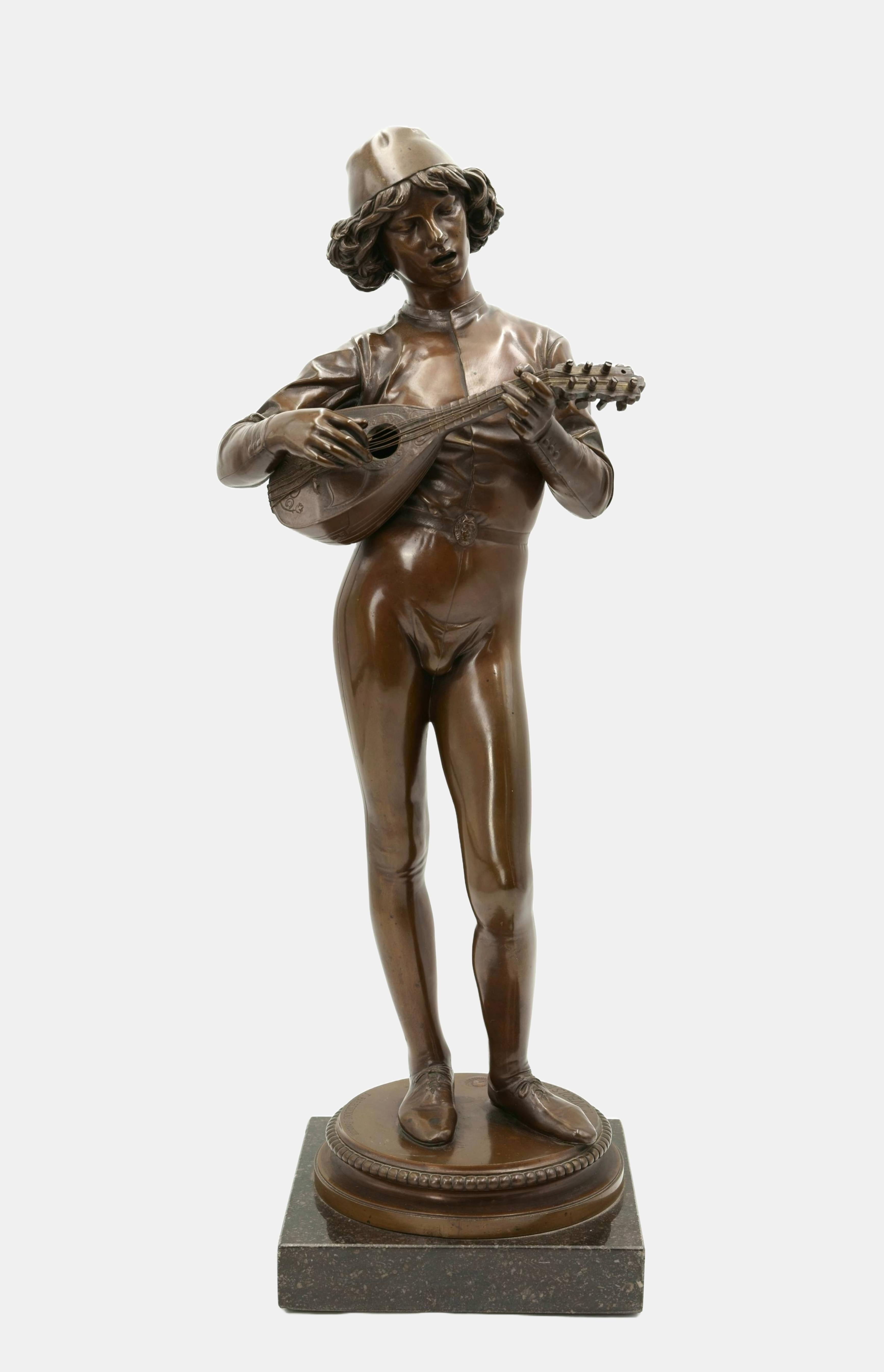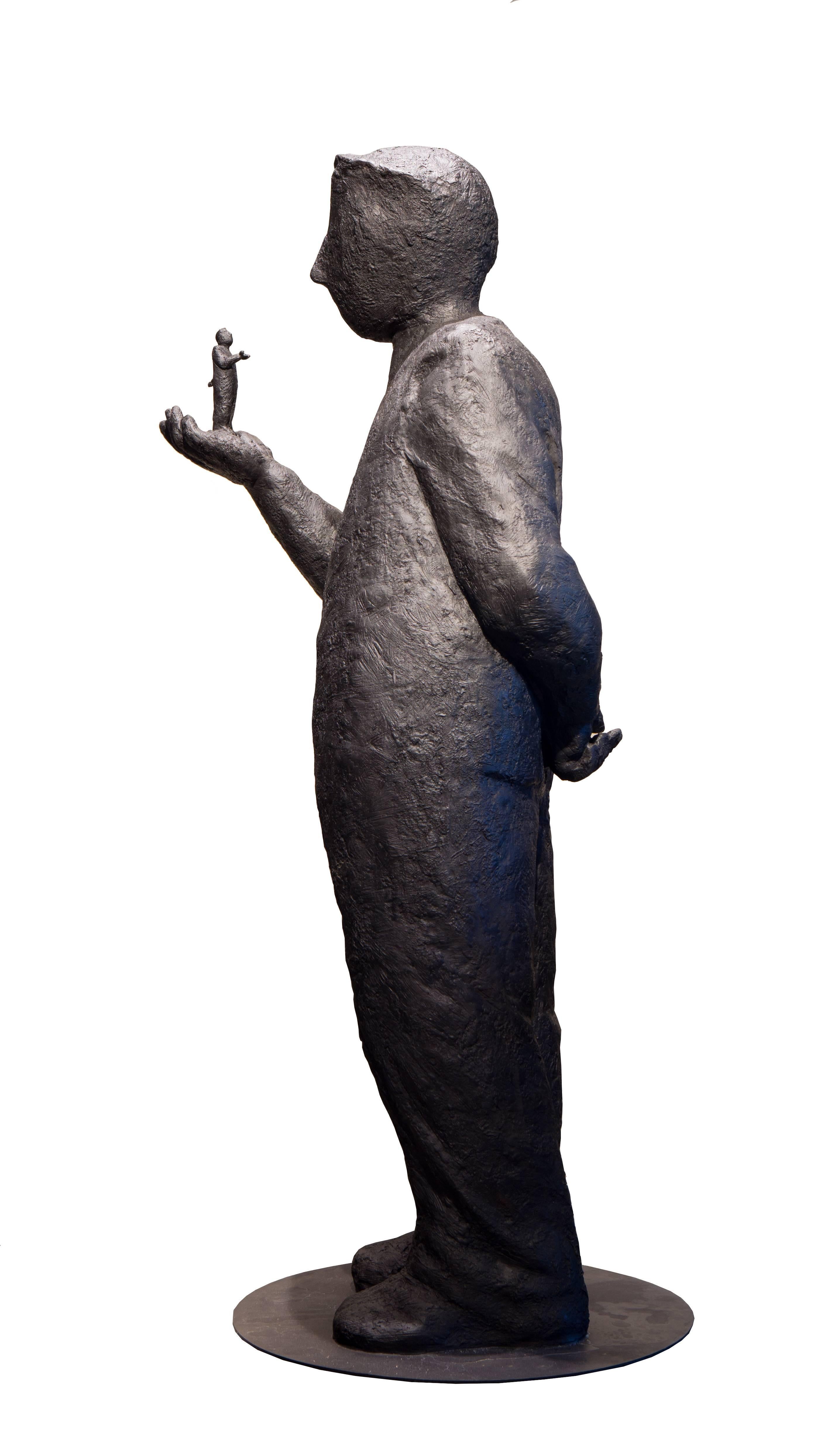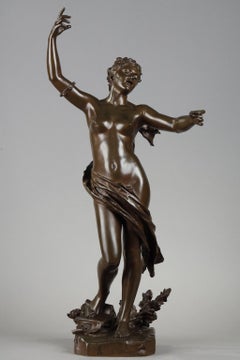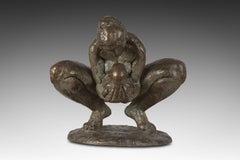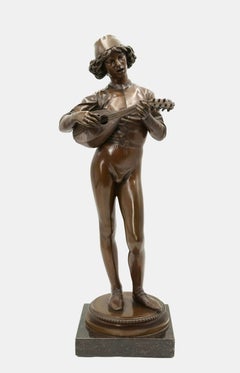Want more images or videos?
Request additional images or videos from the seller
1 of 17
Ernest WanteThe vocal lessoncirca 1910
circa 1910
$10,185.51
£7,558.82
€8,500
CA$14,036.15
A$15,446.64
CHF 8,100.03
MX$187,459.27
NOK 101,249.09
SEK 95,854.84
DKK 64,725.88
About the Item
"The vocal lesson"
Pierrot's Getting His Cats To Sing
by Ernest Wante (1872-1960)
Sculpture in bronze with a dark brown patina
Signed "E. Wante" on the base
Raised on a red marble base
Belgian school
circa 1910
total height 48 cm
Width 29 cm
Biography :
Ernest Wante (1872-1960) was a Belgian painter and sculptor. Born in Ghent, he studied at the Drawing School of Sint-Niklaas, at the Royal Academy of Antwerp and at the Higher Institute of Fine Arts in Antwerp. In 1893, he won the Godecharle prize, which enabled him to go on a study trip to Germany. He has long been a professor at the Antwerp Academy.
Knowing success, Ernest Wante exhibited his painted and sculpted works in Belgium and abroad. He painted landscapes and portraits, but was also known for his frescoes and religious compositions. The wall decorations of this artist are kept in the college churches of Brussels and Antwerp, Bruges, Ghent and Shanghai.
- Creator:Ernest Wante (1872 - 1960, Belgian)
- Creation Year:circa 1910
- Dimensions:Height: 18.9 in (48 cm)Width: 11.42 in (29 cm)Depth: 5.91 in (15 cm)
- Medium:
- Period:
- Condition:
- Gallery Location:PARIS, FR
- Reference Number:Seller: N.70211stDibs: LU2514213482382

About the Seller
5.0
Recognized Seller
These prestigious sellers are industry leaders and represent the highest echelon for item quality and design.
Established in 1992
1stDibs seller since 2023
10 sales on 1stDibs
Typical response time: 9 hours
- ShippingRetrieving quote...Shipping from: PARIS, France
- Return Policy
Authenticity Guarantee
In the unlikely event there’s an issue with an item’s authenticity, contact us within 1 year for a full refund. DetailsMoney-Back Guarantee
If your item is not as described, is damaged in transit, or does not arrive, contact us within 7 days for a full refund. Details24-Hour Cancellation
You have a 24-hour grace period in which to reconsider your purchase, with no questions asked.Vetted Professional Sellers
Our world-class sellers must adhere to strict standards for service and quality, maintaining the integrity of our listings.Price-Match Guarantee
If you find that a seller listed the same item for a lower price elsewhere, we’ll match it.Trusted Global Delivery
Our best-in-class carrier network provides specialized shipping options worldwide, including custom delivery.More From This Seller
View AllThe Comedy
Located in PARIS, FR
Pierre-Marie POISSON (1876-1953)
The Comedy
Bronze sculpture with black patina
signed on the base "P. Poisson"
Cast by Valsuani (with the foundry stamp)
Raised on a stone base
Fra...
Category
1930s French School Figurative Sculptures
Materials
Bronze
Singing
Located in PARIS, FR
Singing
by Hubert YENCESSE (1900-1987)
A bronze sculpture with a nuanced brown patina
signed on the base " H. Yencesse "
cast by " A. Rudier fondeur Paris " (with the foundry mark)
...
Category
1930s French School Figurative Sculptures
Materials
Bronze
Self-portrait
By Christophe Fratin
Located in PARIS, FR
Self-portrait
"Fratin by himself"
by Christophe FRATIN (1801-1864)
Bronze with nuanced dark brown patina
Signed on the base "Fratin"
Raised on a wooden base, with an old collector s...
Category
1840s French School Figurative Sculptures
Materials
Bronze
The Song
By Félix Charpentier
Located in PARIS, FR
"The Song" by Félix Charpentier (1858-1924)
A very fine bronze sculpture with nuanced dark brown patina
Signed "Fx. Charpentier"
Cast by "E. Colin & Cie Paris"
France
around 1900
he...
Category
Early 1900s Art Nouveau Figurative Sculptures
Materials
Bronze
Ravageot and Ravageode
By Emmanuel Fremiet
Located in PARIS, FR
Bronze with nuanced dark brown patina
Old edition cast
version with a leash at the necks of dogs
France
circa 1890
height 14,5 cm
diam. 17 cm
A similar model is reproduced in "Emma...
Category
Late 19th Century French School Figurative Sculptures
Materials
Bronze
Pensive à genoux
By Baltasar Lobo
Located in PARIS, FR
Baltasar LOBO (1910-1993)
Pensive on her knees
A bronze sculpture with a black patina
Signed on the side " Lobo "
Cast by " Susse Fondeur Paris " (with the foundry mark)
Numbered " ...
Category
1970s French School Figurative Sculptures
Materials
Bronze
You May Also Like
Story Teller
By Carol Gold
Located in Loveland, CO
Story Teller by Carol Gold
Abstract Figurative Bronze
Maquette: 24x14x14" ed/10
ABOUT THE ARTIST: Carol Gold was born in Hartford, Connecticut and grew u...
Category
2010s Contemporary Figurative Sculptures
Materials
Bronze
Le Jour by Cibot Bronze
By Elisabeth Cibot
Located in Pasadena, CA
Sculpture - original. Numbered 1/4. Founder GODAR.
Born in 1960 in a family of artists collecting the bronzes of the Italian Renaissance, sculpture has always been part of the en...
Category
1990s Contemporary Figurative Sculptures
Materials
Bronze
$9,600 Sale Price
33% Off
Florentine singer / - The Renaissance of the Renaissance -
By Paul Dubois
Located in Berlin, DE
Paul Dubois (1829 Nogent-sur-Seine - 1905 Paris), Florentine singer, 1865. Light brown patinated bronze with cast round plinth mounted on a square marble base (3.5 cm high). Total height 53 cm. Bronze dimensions: 49.5 cm (height) x 20 cm (length) x 10 cm (width), weight 5.6 kg. Inscribed on the plinth "P.[aul] DUBOIS", dated "1865", with the foundry's mark "F. BARBEDIENNE FONDEUR" and the signet "REDUCTION MECANIQUE A. COLLAS".
- Patina very occasionally darkened, lute with loss of one tuning peg, otherwise in excellent condition.
- The renaissance of the Renaissance -
The bronze is a precisely executed and masterfully cast contemporary reduction of Paul Dubois 155 cm tall masterpiece "Florentine Singer", which is exhibited in the Musée d'Orsay and for which the artist was awarded the Medal of Honor at the Paris Salon in 1865. The work acted as a beacon, and was followed by a plethora of depictions of juveniles.
Inspired by Donatello and Luca della Robbia, but also by painters such as Piero della Francesca, Benozzo Gozzoli, and Pinturicchio, the "Florentine Singer" is not an epigonal work that pays homage to a vanished era, but a successful attempt to draw vitality from the art of the past and thus give it new life.
The effect of vitality is the core of Italian Renaissance art theory. In order to fulfill itself as art, art had to appear like nature. This naturalism also characterizes the "Florentine Singer". The young man appears to have been taken from life, which is reinforced by the momentary nature of his action. He has just struck a now fading chord. In addition, the natural appearance is enhanced by the detailed shaping of the figurative details, such as the laces with the slightly curved leather of the shoes, the belt buckle, or the ornamentation on the body of the lute. Even the fingernails are clearly defined. Unlike the Renaissance, however, the effect of liveliness here is not based on the "discovery" of nature and the human body, but primarily on the rediscovery of the art of the Quattrocento. The liveliness of the artwork is therefore at the same time a revitalization of this art, so that we can speak of a Renaissance of the Renaissance, just as the Pre-Raphaelites in England at the same time transferred the Quattrocento to contemporary art.
Dubois takes on the most difficult of all subjects, the depiction of singing through silent sculpture. He was preceded in this by Luca della Robbia and Donatello with their pulpits of singers created in the 1430s in the Museo dell'Opera del Duomo in Florence. Compared to these works, the physiognomy of Dubois singer is far less animated, yet he also depicts singing in a convincing manner. He uses the whole body. He takes the ancient contrapposto, which was essential to Renaissance sculpture, and transforms the standing leg-playing posture into a late medieval S-swing, giving the body an elegant beauty and at the same time setting it in melodic motion. In the equally elegant finger position, the music is expressed in a much more literal way with the beating of the lute. Finally, the musicality of the sculpture culminates in the face with the mouth open to sing.
Through the act of singing, which is a great challenge to the artistic will to depict perfect beauty, the gracefulness of the classical face is not diminished, but enhanced. Starting from the face with the singing mouth and the gaze absorbed by the sounds, the inner vitality spreads, giving the bronze sculpture an intense aura, enhanced by the music. Dubois transfers the beauty of the Renaissance to the musical, sublimating the visible sculpture to the invisible of music.
He took up the challenge of transcending the Renaissance with the Renaissance, thus responding to the Querelle des Anciens et des Modernes, which arose at the end of the 17th century around the French Academy and remained virulent into the 19th century, in which antiquity was regarded either as an unattainable ideal or as a standard to be surpassed. With his work, Dubois proved that the Renaissance, which had championed the art of the ancients, could lead to a new renaissance of art.
About the artist
Paul Dubois' great-uncle was the famous French Baroque sculptor Jean-Baptiste Pigalle, in whose footsteps the talented great-nephew followed. When he debuted at the Paris Salon in 1858, he signed his work "Dubois-Pigalle". At his father's request, however, he first studied law before devoting himself to sculpture under the tutelage of François Christophe Armand Toussaint in 1856 and entering the École des Beaux-Arts in 1858. From 1859 to 1863, he lived in Rome and traveled to Naples and Florence. Inspired by Florentine art of the quattrocento, Dubois initiated a school-forming neo-Florentine style that combined the elegantly simple forms of youthful grace with a precise wealth of detail.Two purchases by the French state (“envois de Rome”) were made during his stay in Rome, which brought him recognition in Paris. After his return there, he quickly became an internationally sought-after artist.
Dubois was also active as a creator of monuments. His most famous work is the equestrian statue of Joan of Arc (1896) on the forecourt of Reims Cathedral. He was also a sought-after portraitist who produced around 50 busts and - Dubois was also a passionate painter - around 100 portraits in oil.
From 1873 to 1878 he was curator of the Museum du Luxembourg, in 1876 he became a member of the Institut de France and from 1878 to 1905 he was director of the École des Beaux-Arts.
In 1865, Dubois was awarded the Paris Salon Medal of Honor for his “Florentine Singer”. In 1867 he became Chevalier, in 1874 Officier, in 1886 Commandeur of the Légion d'honneur, which awarded Dubois the Grande Croix in 1896.
Selected Bibliography
Stole, Elmar: Paul Dubois. In: Saur. Allgemeines Künstlerlexikon, vol. 30, Munich - Leipzig 2001, pp. 677-678.
GERMAN VERSION
Paul Dubois (1829 Nogent-sur-Seine - 1905 Paris), Florentinischer Sänger, 1865. Hellbraun patinierte Bronze mit gegossener runder Plinthe auf quadratischem Marmorsockel montiert (3,5 cm Höhe). Gesamthöhe 53 cm. Maße der Bronze: 49,5 cm (Höhe) x 20 cm (Länge) x 10 cm (Breite), Gewicht 5,6 kg. Auf der Plinthe mit „P.[aul] DUBOIS“ bezeichnet, auf „1865“ datiert, mit dem Gießereistempel „F. BARBEDIENNE FONDEUR“ und dem Signet „REDUCTION MECANIQUE A. COLLAS“ versehen.
- Patina sehr vereinzelt nachgedunkelt, Laute mit Verlust eines Stimmwirbels, ansonsten ausgezeichnet erhalten.
- Die Renaissance...
Category
1860s Realist Figurative Sculptures
Materials
Bronze
$4,313 Sale Price
20% Off
Inner Dialogue
By Jim Rennert
Located in Greenwich, CT
Edition of 3
American, b. 1958
Jim Rennert was born in 1958, and grew up in Las Vegas, Nevada, and Salt Lake City, Utah. After ten trying years of working in business, Rennert was i...
Category
2010s Contemporary Figurative Sculptures
Materials
Bronze
Price Upon Request
Love Song
Located in Roma, RM
Costantino Barbella (Chieti 1852 - Rome 1925), Love Song
Bronze sculpture 41 x 35 x 21 cm signed at bottom, on black marble base.
Provenance: Private Collection, Rome.
Category
Late 19th Century Other Art Style Figurative Sculptures
Materials
Bronze
Sacra Conversatione Bronze Sculpture Mythology Classic Contemporary
By Margot Homan
Located in Utrecht, NL
Sacra Conversatione Bronze Sculpture Mythology Classic Contemporary
The sculptures of Margot Homan (1956, Oss) show a perfect command of the old ...
Category
21st Century and Contemporary Contemporary Figurative Sculptures
Materials
Bronze
More Ways To Browse
Belgian School
Hayward Oubre
Henri Louis Bouchard
Italian Bronze Sculpture Venus Green
Jack Of The Dust
Jade Horse Carriage
James Muir Bronzes
Jiang Bronze
Jim Darbu
Joe Peters
Joie De Vivre Macdonald
Kaws Ceramic
Kaws The Promise Grey
Keith Haring Dog Sculpture
Kirk Roda
Kissing Cherubs
Lambert Ceramic
Large Brass Leopard
